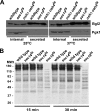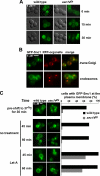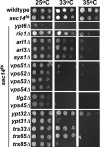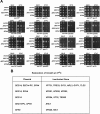Phospholipid transfer protein Sec14 is required for trafficking from endosomes and regulates distinct trans-Golgi export pathways
- PMID: 19129178
- PMCID: PMC2652273
- DOI: 10.1074/jbc.M808732200
Phospholipid transfer protein Sec14 is required for trafficking from endosomes and regulates distinct trans-Golgi export pathways
Abstract
A protein known to regulate both lipid metabolism and vesicular transport is the phosphatidylcholine/phosphatidylinositol transfer protein Sec14 of Saccharomyces cerevisiae. Sec14 is thought to globally affect secretion from the trans-Golgi. The results from a synthetic genetic array screen for genes whose inactivation impaired growth of cells with a temperature-sensitive SEC14 allele implied Sec14 regulates transport into and out of the Golgi. This prompted us to examine the role of Sec14 in various vesicular transport pathways. We determined that Sec14 function was required for the route followed by Bgl2, whereas trafficking of other secreted proteins, including Hsp150, Cts1, Scw4, Scw10, Exg1, Cis3, and Ygp1, still occurred, indicating Sec14 regulates specific trans-Golgi export pathways. Upon diminution of Sec14 function, the v-SNARE Snc1 accumulated in endosomes and the trans-Golgi. Its accumulation in endosomes is consistent with Sec14 being required for transport from endosomes to the trans-Golgi. Sec14 was also required for trafficking of Ste3 and the lipophilic dye FM4-64 from the plasma membrane to the vacuole at the level of the endosome. The combined genetic and cell biology data are consistent with regulation of endosome trafficking being a major role for Sec14. We further determined that lipid ligand occupancy differentially regulates Sec14 functions.
Figures








Similar articles
-
Surprising roles for phospholipid binding proteins revealed by high throughput genetics.Biochem Cell Biol. 2010 Aug;88(4):565-74. doi: 10.1139/O09-171. Biochem Cell Biol. 2010. PMID: 20651827 Review.
-
Functional anatomy of phospholipid binding and regulation of phosphoinositide homeostasis by proteins of the sec14 superfamily.Mol Cell. 2008 Feb 1;29(2):191-206. doi: 10.1016/j.molcel.2007.11.026. Mol Cell. 2008. PMID: 18243114 Free PMC article.
-
Membrane metabolism mediated by Sec14 family members influences Arf GTPase activating protein activity for transport from the trans-Golgi.Proc Natl Acad Sci U S A. 2005 Sep 6;102(36):12777-82. doi: 10.1073/pnas.0506156102. Epub 2005 Aug 26. Proc Natl Acad Sci U S A. 2005. PMID: 16126894 Free PMC article.
-
Trans-Golgi network and endosome dynamics connect ceramide homeostasis with regulation of the unfolded protein response and TOR signaling in yeast.Mol Biol Cell. 2008 Nov;19(11):4785-803. doi: 10.1091/mbc.e08-04-0426. Epub 2008 Aug 27. Mol Biol Cell. 2008. PMID: 18753406 Free PMC article.
-
Sec14 like PITPs couple lipid metabolism with phosphoinositide synthesis to regulate Golgi functionality.Subcell Biochem. 2012;59:271-87. doi: 10.1007/978-94-007-3015-1_9. Subcell Biochem. 2012. PMID: 22374094 Free PMC article. Review.
Cited by
-
Marine-Derived Metabolites Act as Promising Antifungal Agents.Mar Drugs. 2024 Apr 17;22(4):180. doi: 10.3390/md22040180. Mar Drugs. 2024. PMID: 38667797 Free PMC article. Review.
-
Distinct roles of the polarity factors Boi1 and Boi2 in the control of exocytosis and abscission in budding yeast.Mol Biol Cell. 2017 Nov 1;28(22):3082-3094. doi: 10.1091/mbc.E17-06-0404. Epub 2017 Sep 13. Mol Biol Cell. 2017. PMID: 28904204 Free PMC article.
-
The MADS-Box transcription factor Bcmads1 is required for growth, sclerotia production and pathogenicity of Botrytis cinerea.Sci Rep. 2016 Sep 23;6:33901. doi: 10.1038/srep33901. Sci Rep. 2016. PMID: 27658442 Free PMC article.
-
Localization of lipid raft proteins to the plasma membrane is a major function of the phospholipid transfer protein Sec14.PLoS One. 2013;8(1):e55388. doi: 10.1371/journal.pone.0055388. Epub 2013 Jan 30. PLoS One. 2013. PMID: 23383173 Free PMC article.
-
Lipid binding requirements for oxysterol-binding protein Kes1 inhibition of autophagy and endosome-trans-Golgi trafficking pathways.J Biol Chem. 2010 Oct 29;285(44):33875-84. doi: 10.1074/jbc.M110.147264. Epub 2010 Aug 21. J Biol Chem. 2010. PMID: 20729555 Free PMC article.
References
-
- Patton-Vogt, J. L., Griac, P., Sreenivas, A., Bruno, V., Dowd, S., Swede, M. J., and Henry, S. A. (1997) J. Biol. Chem. 272 20873-20883 - PubMed
-
- Fernandez-Murray, J. P., and McMaster, C. R. (2005) J. Biol. Chem. 280 8544-8552 - PubMed
-
- Sreenivas, A., Patton-Vogt, J. L., Bruno, V., Griac, P., and Henry, S. A. (1998) J. Biol. Chem. 273 16635-16638 - PubMed
Publication types
MeSH terms
Substances
LinkOut - more resources
Full Text Sources
Molecular Biology Databases
Research Materials

